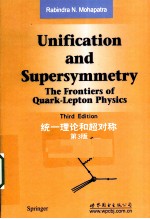图书介绍
统一理论和超对称 第3版 英文版2025|PDF|Epub|mobi|kindle电子书版本百度云盘下载

- (美)莫哈帕特拉著 著
- 出版社: 北京;西安:世界图书出版公司
- ISBN:9787510005718
- 出版时间:2010
- 标注页数:421页
- 文件大小:15MB
- 文件页数:440页
- 主题词:大统一理论-英文;超对称-英文
PDF下载
下载说明
统一理论和超对称 第3版 英文版PDF格式电子书版下载
下载的文件为RAR压缩包。需要使用解压软件进行解压得到PDF格式图书。建议使用BT下载工具Free Download Manager进行下载,简称FDM(免费,没有广告,支持多平台)。本站资源全部打包为BT种子。所以需要使用专业的BT下载软件进行下载。如BitComet qBittorrent uTorrent等BT下载工具。迅雷目前由于本站不是热门资源。不推荐使用!后期资源热门了。安装了迅雷也可以迅雷进行下载!
(文件页数 要大于 标注页数,上中下等多册电子书除外)
注意:本站所有压缩包均有解压码: 点击下载压缩包解压工具
图书目录
1 Important Basic Concepts in Particle Physics1
1.1 Introduction1
1.2 Symmetries and Currents4
1.3 Local Symmetries and Yang-Mills Fields8
1.4 Quantum Chromodynamic Theory of Strong Interactions11
1.5 Hidden Symmetries of Weak Interactions14
References18
2 Spontaneous Symmetry Breaking21
2.1 Symmetries and Their Realizations21
2.2 Nambu-Goldstone Bosons for an Arbitrary Non-Abelian Group24
2.3 Some Properties of Nambu-Goldstone Bosons26
2.4 Phenomenology of Massless and Near-Massless Spin-0 Bosons28
2.5 The Higgs-Kibble Mechanism in Gauge Theories30
2.6 Group Theory of the Higgs Phenomenon33
2.7 Renormalizability and Triangle Anomalies34
References36
3 The SU(2)L×U(1) Model38
3.1 The SU(2)L×U(1) Model of Glashow,Weinberg,and Salam38
3.2 Neutral-Current Interactions43
3.3 Masses and Decay Properties of W and Z Bosons47
3.4 Fermion Masses and Mixing52
3.5 Higher-Order-Induced Flavor-Changing Neutral-Current Effects54
3.6 The Higgs Bosons56
3.7 SU(2)L×U(1) Model with Two Higgs Doublets59
3.8 Puzzles of the Standard Model61
3.9 Outline of the Various Scenarios64
3.10 Beyond the Standard Model64
References71
4 CP Violation:Weak and Strong74
4.1 CP Violation in Weak Interactions74
4.2 CP Violation in Gauge Models:Generalities78
4.3 The Kobayashi-Maskawa Model80
4.4 Left-Right Symmetric Models of CP Violation85
4.5 The Higgs Exchange Models92
4.6 Strong CP Violation and the θ-Problem94
4.7 Solutions to the Strong CP Problem without the Axion98
4.8 Summary100
References102
5 Grand Unification and the SU(5) Model106
5.1 The Hypothesis of Grand Unification106
5.2 SU(N) Grand Unification107
5.3 Sin2θW in Grand Unified Theories(GUT)108
5.4 SU(5)109
5.5 Grand Unification Mass Scale and Sin2θW at Low Energies114
5.6 Detailed Predictions of the SU(5) Model for Proton Decay118
5.7 Some Other Aspects of the SU(5) Model121
5.8 Gauge Coupling Unification with Intermediate Scales before Grand Unification125
References128
6 Symmetric Models of Weak Interactions and Massive Neutrinos130
6.1 Why Left-Right Symmetry?130
6.2 The Model,Symmetry Breaking,and Gauge Boson Masses133
6.3 Limits on MZR and mWR from Charged-Current Weak Interactions140
6.3.1 Limits on the WR-WL Mixing Parameter ?145
6.4 Properties of Neutrinos and Lepton-Number-Violating Processes146
6.5 Baryon Number Nonconservation and Higher Unification157
6.6 Sin2θW and the Scale of Partial Unification163
6.7 Left-Right Symmetry—An Alternative Formulation164
6.8 Higher Order Effects166
6.9 Conclusions168
References170
7 SO(10) Grand Unification175
7.1 Introduction175
7.2 SO(2N) in an SU(N) Basis[3]176
7.3 Fermion Masses and the"Charge Conjugation" Operator179
7.4 Symmetry-Breaking Patterns and Intermediate Mass Scales183
7.5 Decoupling Parity and SU(2)R Breaking Scales189
7.6 Second Z' Boson191
References192
8 Technicolor and Compositeness193
8.1 Why Compositeness?193
8.2 Technicolor and Electroweak Symmetry Breaking194
8.3 Techni-Composite Pseudo-Goldstone Bosons197
8.4 Fermion Masses199
8.5 Composite Quarks and Leptons201
8.6 Light Quarks and Leptons and't Hooft Anomaly Matching204
8.7 Examples of 't Hooft Anomaly Matching206
8.8 Some Dynamical Constraints on Composite Models209
8.9 Other Aspects of Composite Models210
8.10 Symmetry Breaking via Top-Quark Condensate213
References216
9 Global Supersymmetry220
9.1 Supersymmetry220
9.2 A Supersymmetric Field Theory222
9.3 Two-Component Notation225
9.4 Superfields227
9.5 Vector and Chiral Superfields230
References235
10 Field Theories with Global Supersymmetry236
10.1 Supersymmetry Action236
10.2 Supersymmetric Gauge Invariant Lagrangian240
10.3 Feynman Rules for Supersymmetric Theories[3]242
10.4 Allowed Soft-Breaking Terms246
References248
11 Broken Supersymmetry and Application to Particle Physics249
11.1 Spontaneous Breaking of Supersymmetry249
11.2 Supersymmetric Analog of the Goldberger-Treiman Relation251
11.3 D-Type Breaking of Supersymmetry253
11.4 O'Raifeartaigh Mechanism or F-Type Breaking of Supersymmetry254
11.5 A Mass Formula for Supersymmetric Theories and the Need for Soft Breaking256
References258
12 Minimal Supersymmetric Standard Model260
12.1 Introduction,Field Content and the Lagrangian260
12.2 Constraints on the Masses of Superparticles268
12.3 Other Effects of Superparticles273
12.4 Why Go beyond the MSSM?276
12.5 Mechanisms for Supersymmetry Breaking277
12.6 Renormalization of Soft Supersymmetry-Breaking Parameters284
12.7 Supersymmetric Left-Right Model286
References291
13 Supersymmetric Grand Unification293
13.1 The Supersymmetric SU(5)293
13.2 Proton Decay in the Supersymmetry SU(5) Model296
13.2.1 Problems and Prospects for SUSY SU(5)299
13.3 Supersymmetric SO(10)301
13.3.1 Symmetry Breaking and Fermion Masses301
13.3.2 Neutrino Masses,R-Parity Breaking,126 vrs.16304
13.3.3 Doublet-Triplet Splitting(D-T-S):306
References308
14 Local Supersymmetry(N=1)310
14.1 Connection Between Local Supersymmetry and Gravity310
14.2 Rarita-Schwinger Formulation of the Massless Spin-3/2 Field312
14.3 Elementary General Relativity313
14.4 N=1 Supergravity Lagrangian316
14.5 Group Theory of Gravity and Supergravity Theories317
14.6 Local Conformal Symmetry and Gravity320
14.7 Conformal Supergravity and Matter Couplings323
14.8 Matter Couplings and the Scalar Potential in Supergravity327
14.9 Super-Higgs Effect331
14.10 Different Formulations of Supergravity332
References334
15 Application of Supergravity(N=1) to Particle Physics335
15.1 Effective Lagrangian from Supergravity335
15.2 The Polonyi Model of Supersymmetry Breaking337
15.3 Electroweak Symmetry Breaking and Supergravity340
15.4 Grand Unification and N=1 Supergravity343
References347
16 Beyond N=1 Supergravity348
16.1 Beyond Supergravity348
16.2 Extended Supersymmetries(N=2)349
16.3 Supersymmetries with N>2351
16.4 Higher-Dimensional Supergravity Theories352
16.5 d=10 Super-Yang-Mills Theory356
References359
17 Superstrings and Quark-Lepton Physics361
17.1 Introduction to Strings361
17.2 Light Cone Quantization and Vacuum Energy of the String368
17.3 Neveu-Schwarz and Ramond Strings370
17.4 GSO Projection and Supersymmetric Spectrum372
17.5 Heterotic String374
17.6 N=1 Super-Yang-Mills Theory in Ten Dimensions376
17.7 Compactification and the Calabi-Yau Manifold377
17.8 Brief Introduction to Complex Manifolds381
17.9 Calabi-Yau Manifolds and Polynomial Representations for(2,1) Forms383
17.10 Assignment of Particles,the E6-GUT Model[18],and Symmetry Breaking388
17.11 Supersymmetry Breaking398
17.12 Cosmological Implications of the Intermediate Scale401
17.13 A Real Superstring Model with Four Generations402
17.14 String Theories,Extra Dimensions,and Gauge Coupling Unification407
17.14.1 Weakly Coupled Heterotic String,Mass Scales,and Gauge Coupling Unification407
17.14.2 Strongly Coupled Strings,Large Extra Dimensions,and Low String Scales408
17.14.3 Effect of Extra Dimensions on Gauge Coupling Unification409
17.15 Conclusion412
References413
Index419